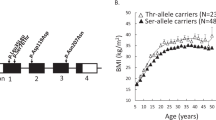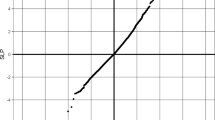Abstract
Recently, the prevalence of childhood obesity has significantly increased in industrialized countries, including Korea, and now controlling obesity is becoming an economic burden. However, knowledge of the risk factors associated with obesity is still limited. In this study, we aimed to discover additional obesity-associated loci in children. To achieve this, we conducted an exome-wide association analysis of copy number variation (CNV) using whole-exome sequencing (WES) data from a total of 102 cases and 86 controls. We newly identified a CNV locus that overlapped two protocadherin genes, PCDHB7 and PCDHB8, which are brain function-related genes (P-value=6.40 × 10−4, odds ratio=2.2189). A subsequent replication analysis using WES data from 203 obese and 291 normal weight children showed that this CNV region satisfied the genome-wide significance standard (Fisher’s combined P-value=3.76 × 10−5). Moreover, correlation test using 199 additional samples supported significant association between CNV and increased body mass index. This region also showed a meaningful association with 273 cases and 2596 controls in adult samples. Our findings suggest that differences in the common CNV region at 5q31.3 may have an impact on the pathophysiology of obesity.
This is a preview of subscription content, access via your institution
Access options
Subscribe to this journal
Receive 12 print issues and online access
$259.00 per year
only $21.58 per issue
Buy this article
- Purchase on Springer Link
- Instant access to full article PDF
Prices may be subject to local taxes which are calculated during checkout

Similar content being viewed by others
References
Racette SB, Deusinger SS, Deusinger RH . Obesity: overview of prevalence, etiology, and treatment. Phys Ther 2003; 83: 276–288.
Haslam DW, James WP . Obesity. Lancet 2005; 366: 1197–1209.
Zhao J, Grant SF . Genetics of childhood obesity. J Obes 2011; 2011: 845148.
Lim H, Xue H, Wang Y . Association between obesity and metabolic co-morbidities among children and adolescents in South Korea based on national data. BMC Public Health 2014; 14: 279.
Fall T, Ingelsson E . Genome-wide association studies of obesity and metabolic syndrome. Molec Cell Endocrinol 2014; 382: 740–757.
Locke AE, Kahali B, Berndt SI, Justice AE, Pers TH, Day FR et al. Genetic studies of body mass index yield new insights for obesity biology. Nature 2015; 518: 197–206.
Speliotes EK, Willer CJ, Berndt SI, Monda KL, Thorleifsson G, Jackson AU et al. Association analyses of 249,796 individuals reveal 18 new loci associated with body mass index. Nat Genet 2010; 42: 937–948.
World Health Organization (WHO)Obesity: Preventin g and Managing the Global Epidemic : Report of a WHO Consultation on Obesity. WHO: Geneva, 1998.
World Health Organization. Regional Office for the Western PacificThe Asia-Pacific Perspective: Redefining Obesity and its Treatment. International Diabetes Institute, International Association for the Study of Obesity, International Obesity Task Force Publisher. Health Communications Australia Pty Limited: Sydney, New South Wales, Australia 2000.
Hwang MY, Moon S, Heo L, Kim YJ, Oh JH, Kim YK et al. Combinatorial approach to estimate copy number genotype using whole-exome sequencing data. Genomics 2015; 105: 145–149.
Plagnol V, Curtis J, Epstein M, Mok KY, Stebbings E, Grigoriadou S et al. A robust model for read count data in exome sequencing experiments and implications for copy number variant calling. Bioinformatics 2012; 28: 2747–2754.
Moon S, Jung KS, Kim YJ, Hwang MY, Han K, Lee JY et al. KGVDB: a population-based genomic map of CNVs tagged by SNPs in Koreans. Bioinformatics 2013; 29: 1481–1483.
Walters RG, Jacquemont S, Valsesia A, de Smith AJ, Martinet D, Andersson J et al. A new penetrant form of obesity due to deletions on chromosome 16p11.2. Nature 2010; 463: 671–675.
Morishita H, Yagi T . Protocadherin family: diversity, structure, and function. Curr Opin Cell Biol 2007; 19: 584–592.
Ruderfer DM, Hamamsy T, Lek M, Karczewski KJ, Kavanagh D, Samocha KE et al. Patterns of genic intolerance of rare copy number variation in 59,898 human exomes. Nat Genet 2016; 48: 1107–1111.
Mariman EC, Bouwman FG, Aller EE, van Baak MA, Wang P . High frequency of rare variants with a moderate-to-high predicted biological effect in protocadherin genes of extremely obese. Genes Nutr 2014; 9: 399.
Comuzzie AG, Cole SA, Laston SL, Voruganti VS, Haack K, Gibbs RA et al. Novel genetic loci identified for the pathophysiology of childhood obesity in the Hispanic population. PloS ONE 2012; 7: e51954.
Fox CS, Liu Y, White CC, Feitosa M, Smith AV, Heard-Costa N et al. Genome-wide association for abdominal subcutaneous and visceral adipose reveals a novel locus for visceral fat in women. PLoS Genet 2012; 8: e1002695.
Borghol N, Suderman M, McArdle W, Racine A, Hallett M, Pembrey M et al. Associations with early-life socio-economic position in adult DNA methylation. Int J Epidemiol 2012; 41: 62–74.
Balwierz A, Polus A, Razny U, Wator L, Dyduch G, Tomaszewska R et al. Angiogenesis in the New Zealand obese mouse model fed with high fat diet. Lipids Health Dis 2009; 8: 13.
Acknowledgements
This work was supported by intramural grants from the Korea National Institute of Health (2012-N73004-00, 2014-NI73001-00, 2012-E64001-00). Data were also provided by the Korean Genome Analysis Project (4845-301) and the Korean Genome and Epidemiology Study (4851-302) that were supported by the Korea Center for Disease Control and Prevention, Republic of Korea.
Author information
Authors and Affiliations
Corresponding author
Ethics declarations
Competing interests
The authors declare no conflict of interest.
Additional information
Supplementary Information accompanies this paper on International Journal of Obesity website
Supplementary information
Rights and permissions
About this article
Cite this article
Moon, S., Hwang, M., Jang, H. et al. Whole-exome sequencing study reveals common copy number variants in protocadherin genes associated with childhood obesity in Koreans. Int J Obes 41, 660–663 (2017). https://doi.org/10.1038/ijo.2017.12
Received:
Revised:
Accepted:
Published:
Issue Date:
DOI: https://doi.org/10.1038/ijo.2017.12



